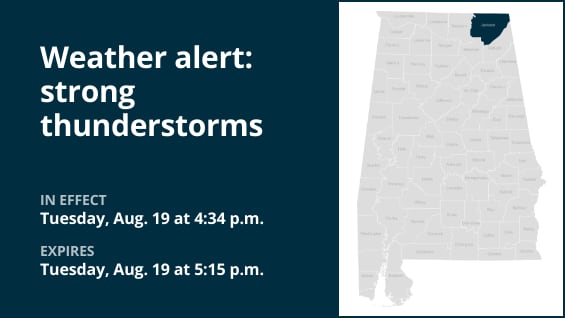The National Weather Service issued a weather alert for Jackson County on Tuesday at 4:34 p.m. for severe thunderstorms until 5:15 p.m.
Wind gusts of up to 40 mph are anticipated for the local population.
Doppler radar detected a powerful thunderstorm over Skyline, which is 13 miles north of Scottsboro, at 4:34 p.m. According to the weather service, “this thunderstorm was almost stationary.” “Gusty winds could knock down tree limbs and blow around unsecured objects.”
Scottsboro, Pleasant Groves, and Skyline are all under alert.
The weather service states that “If outdoors, consider seeking shelter inside a building.”
Preparing for impending lightning strikes: Expert safety recommendations
About 25 million lightning strikes occur in the US annually, primarily in the summer. The weather service estimates that it kills around 20 people a year. As thunderstorms get closer, the risk of lightning increases; it peaks when the storm is directly overhead and then progressively decreases as it passes.
Think about the following suggestions to make sure you’re safe during a thunderstorm.:
Plan for lightning safety:
-
When venturing outdoors, it’s vital to establish a clear plan for seeking shelter in case of lightning.
-
Stay vigilant by monitoring the sky for ominous signs and listening for the telltale sound of thunder. If thunder is audible, it’s a clear indication of nearby lightning.
-
Seek shelter promptly in a safe location, preferably indoors.
Indoor safety precautions:
-
Once you’re indoors, avoid using corded phones, electrical devices, plumbing fixtures, and stay away from windows and doors.
-
Lightning can follow conductive pathways, and these precautions reduce the risk of electrical surges.
Hold off till the all-clear:
-
After the last lightning strike or thunderclap, wait at least 30 minutes before resuming outdoor activities.
-
It’s important to remember that lightning can strike even when a storm seems to have passed, so exercise caution.
When there is no indoor shelter:
Take these precautions to increase your safety if you are outside during a thunderstorm without access to indoor shelter:
-
Avoid open fields, hilltops, or ridge crests, which expose you to greater lightning risk.
-
Steer clear of tall, isolated trees and other prominent objects. In wooded areas, stay close to lower stands of trees.
-
If you’re with a group, ensure individuals are spread out to prevent lightning current from transferring between people.
-
Camping in an open setting during a thunderstorm is strongly discouraged. If no alternative exists, set up camp in a valley, ravine, or other low-lying areas. Remember that a tent offers no protection against lightning.
-
Do not approach water bodies, wet objects, or metal items. While water and metal don’t attract lightning, they conduct electricity effectively and can pose significant risks.
In conclusion, readiness and alertness are your greatest allies while dealing with the threat of lightning. You may put your safety first and drastically lower the chance of lightning-related mishaps by adhering to these rules.
Navigating rainy roads: Safety tips for wet weather
If heavy rainfall persists or if runoff is substantial, flooding may result. Saturated soils and/or heavy rainfall can cause excessive runoff. To keep safe during periods of intense rain, heed these weather service recommendations:
Watch out for swift water flow:
Avoid parking or strolling close to culverts or drainage ditches during periods of intense precipitation, as the swift-moving water can be quite dangerous.
Keep your distances from other vehicles safe:
Keep a safe distance from the automobile ahead of you by following the two-second rule, and give yourself an extra two seconds if it’s raining a lot.
Reduce your speed and drive carefully:
It’s crucial to slow down on wet roads. To avoid sliding, reduce the accelerator gradually and don’t brake suddenly.
Pick your lane carefully:
On multilane highways, stay in the middle lanes to reduce the chance of hydroplaning because water tends to pool in the outer lanes.
Visibility is important.
Turn on your headlights to improve visibility in severe rain. Rain-stained windows can make it difficult to see cars in blind spots, so be especially alert for them.
Be cautious on slick roads:
During the first half hour after the rain starts, exercise additional caution. The road becomes slick when water combines with dirt and oil on the surface.
Stay a safe distance away from big cars:
Tire spray from big vehicles and buses can make it harder to see. Be careful when passing and refrain from tailgating.
Be mindful of your wipers:
Visibility may be hampered by overloaded wiper blades. If the rain significantly impairs your vision, stop and wait for the weather to clear up. Seek cover in safe spaces or rest areas.
If you can’t avoid the roadside, pull off as far as you can, ideally past the end of a guard rail, and wait for the storm to pass. To let other cars know where you are, turn on your emergency flashers and keep your headlights on.
Taking these safety measures will significantly improve your road safety while it’s raining a lot. For a safe trip, keep yourself updated on weather conditions and follow local authorities’ instructions.
United Robots offers a service called Advance Local Weather Alerts that gathers the most recent information from the National Weather Service using machine learning.






